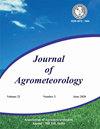Effect of abiotic factors on pathotypes causing yellow and brown rust in wheat
Q3 Agricultural and Biological Sciences
引用次数: 0
Abstract
An attempt was made to determine the most favourable abiotic factors influencing germination of urediniospores of different pathotypes of Puccinia species. The causal organism of rusts in wheat is Puccinia spp. Five pathotypes of Puccinia striiformis (46S119, 78S84, 110S84, 110S119, 238S119) causal organism of yellow rust and two pathotypes of Puccinia triticina (77-5 and 77-9) causal organism of brown rust in wheat were obtained from Department of Plant Pathology, Punjab Agricultural University, Ludhiana. The data related to spore germination on agar slides was analysed and the levels of urediniospores germination at different temperatures (5,10,15 and 20oC) and pH (5,6,7 and 8) for each pathotype was compared using analysis of variance. The most appropriate temperature and pH were later used to conduct an experiment to study effect of different light intensities (500, 750,1000 and 1250 lux) on spore germination of all the pathotypes under study. The data showed that on agar, 15°C was proved as most suitable for urediniospore germination for Puccinia striiformis. Mean per cent spore germination was highest over the temperature range 15°C (43.55%) for Pst pathoypes and dropped significantly at 10°C (37.97%), 20°C (29.66%) and 5°C (21.04%). Mean urediniospore germination for Puccinia triticina was highest at 20°C (43.89%) followed by 15°C (39.44%), 10°C (30.43) and 5°C (27.39% ). Experimental results revealed that per cent spore germination was better under pH 7 followed by 6, 5 and 8 for all the pathotypes considered for study. The highest urediniospore germination was observed for 1250 lux (46.54%) followed by 1000 lux (41.29%), 750 lux (38.42%) and 500 lux (27.60%).非生物因子对小麦黄锈病和褐锈病病原菌的影响
试图确定影响不同致病类型Puccinia种脲孢子萌发的最有利的非生物因素。小麦锈病的病原菌为Puccinia spp.从卢迪亚纳旁遮普邦农业大学植物病理学系获得了黄锈的五种致病型(46S119、78S84、110S84、110 S119、238S119)病原菌和小麦褐锈的两种致病型小麦Puccinio triticina(77-5和77-9)病原菌。分析了琼脂载玻片上孢子萌发的相关数据,并使用方差分析比较了不同温度(5、10、15和20℃)和pH(5、6、7和8)下每种病理类型的脲孢子萌发水平。随后使用最合适的温度和pH进行实验,以研究不同光照强度(500、7501000和1250lux)对所研究的所有病理类型的孢子萌发的影响。结果表明,在琼脂培养基上,15°C最适合条锈菌的孢子萌发。Pst病型的平均孢子发芽率在15°C(43.55%)的温度范围内最高,在10°C(37.97%)、20°C(29.66%)和5°C(21.04%)时显著下降。小麦Puccinia triticina的平均urediniospore发芽率在20°C时最高(43.89%),其次是15°C,39.44%,10°C,30.43%和5°C。实验结果表明,在pH为7的条件下,孢子发芽率更好,其次是6、5和8。在1250勒克斯(46.54%)下观察到最高的脲孢子萌发,其次是1000勒克斯(41.29%)、750勒克斯(38.42%)和500勒克斯(27.60%)。
本文章由计算机程序翻译,如有差异,请以英文原文为准。
求助全文
约1分钟内获得全文
求助全文
来源期刊

Journal of Agrometeorology
农林科学-农艺学
CiteScore
1.40
自引率
0.00%
发文量
95
审稿时长
>12 weeks
期刊介绍:
The Journal of Agrometeorology (ISSN 0972-1665) , is a quarterly publication of Association of Agrometeorologists appearing in March, June, September and December. Since its beginning in 1999 till 2016, it was a half yearly publication appearing in June and December. In addition to regular issues, Association also brings out the special issues of the journal covering selected papers presented in seminar symposia organized by the Association.
 求助内容:
求助内容: 应助结果提醒方式:
应助结果提醒方式:


